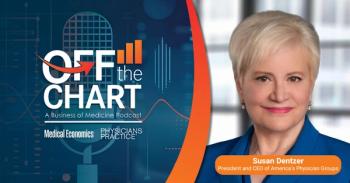
How the MIPS proposed rule could affect your practice
A closer look at the changes Centers for Medicare & Medicaid Services has proposed in its 2019 Merit-based Incentive Payment System (MIPS) that can significantly affect physicians, clinicians, and their Medicare reimbursement.
It’s that wonderful time of year again when the Centers for Medicare and Medicaid Services (CMS) issues its proposed rule for the upcoming year.
CMS has proposed several new changes that can significantly affect physicians, clinicians, and their Medicare reimbursement. CMS reported from data collected in 2017 that 91 percent of physicians and clinicians who had to participate in MIPS did.
This 2019 proposed rule for The Medicare Access and CHIP Reauthorization Act (MACRA)/Merit-based Incentive Payment System (MIPS) for the 2019 performance period makes it more difficult in some aspects for physicians and clinicians to comply, while other changes are actually going to make it easier. For example, those individuals, groups, or virtual groups that do not fully understand these potential changes-and prepare for them-can lose as much as 7 percent of their Medicare reimbursement in 2021, a reduction that could crush most medical practices.
Here’s a closer look at four key proposed changes to MACRA/MIPS.
Who must now comply?
Currently, MIPS requires that physicians, physician assistants, nurse practitioners, clinical nurse specialists, certified registered nurse anesthetists, and a group that includes such professionals, as required by statute. If the proposed changes are made, all of these groups will continue to be required to comply. The following must also comply with MIPS requirements: physical therapists, occupational therapists, clinical social workers, and clinical psychologists.
CMS is clearly increasing the pool of medical professionals who have to comply. Doing so may mean more money is available for physicians and clinicians who fully comply with MIPS requirements. It could also mean that there is less money for increases because even more groups now have to comply.
MIPS is required by law to be budget neutral, so if more clinicians are required to comply, and actually do so, there would be less money to dole out. This means that the 7 percent you might expect to get because you got a 100 percent overall MIPS score might actually be 3 percent or less because there isn’t enough money to share as originally promised. Therefore, it is important for you to max out your MIPS score as much as possible, so that you can get as much of an increase in your Medicare Part B as CMS decides to dole out. Be prepared to get less of an increase than you could expect from the law while also looking at additional ways to increase revenue going forward.
Who is still excluded?
The 2019 MIPS proposed rule indicates that CMS plans to keep, for the most part, the exclusion requirements for MIPS the same as they were in 2018. Those exclusions stated that physicians or clinicians would not have to comply with MIPS if they either were new to Medicare, were part of an Advanced Payment Model (APM), or met one of the following two criterion under the low-volume threshold exclusion: (1) the physician or clinician had less than $90,000 in Part B allowed charges for covered professional services; or (2) they provided care to less than 200 Medicare Part B beneficiaries.
One change CMS is proposing for 2019 is that there would be third criterion for determining MIPS eligibility. That third criterion is that physicians or clinicians provided less than 200 covered professional services under the Physician Fee Schedule (PFS). Therefore, under the proposed rule, you would only have to not meet one of the three criteria for the low-volume threshold to be excluded. This may not cause a ripple effect, as most physicians or clinicians who already comply would still meet all three criteria.
Who needs to opt in?
MIPS does not currently allow physicians or clinicians who wish to participate in MIPS, but are otherwise excluded, to opt in and therefore become eligible for potential Medicare Part B increases. CMS is proposing to change that.
Physicians and clinicians who are otherwise excluded could opt in and become eligible for Medicare Part B increases as long as they met or exceeded one or two, but not all, of the low volume threshold criterion. For example, say Dr. Jones in Indiana had $100,000 in allowed charges for covered professional services and provided 250 covered professional services under the PFS, but did not provide care to more than 200 Medicare beneficiaries. He could now opt in and comply with MIPS and become eligible for the increases to his Medicare Part B reimbursement.
The only way doctors will decide to opt in, when they otherwise would not have to, is if they do the math and determine that if they comply, and can increase their Medicare Part B even a small percentage, it would be profitable for them. Physicians are frustrated and are becoming burned out with all the regulations they currently have to comply with, so opting in might just be more frustration for them, and not worth the hassle. No doctor is looking for more regulations to have to comply with if they do not have to.
Who could be affected as performance category weights change?
In 2018, the categories of MIPS are currently weighted as follows for physicians or clinicians who have to comply: (1) Quality is 50 percent; (2) Promoting Interoperability, formerly Advancing Care Information, category is 25 percent; (3) Improvement Activities category is 15 percent; and (4) Cost category is 10 percent of the overall MIPS score.
For 2019, CMS proposes the following changes to the weights of the four categories of MIPS for physicians and clinicians who have to comply: (1) Quality would be 45 percent; (2) Promoting Interoperability would be 25 percent; (3) Improvement Activities would be 15 percent; and (4) Cost would be 15 percent of the overall MIPS score.
Why are these changes significant? CMS has proposed that in 2019, in order for physicians or clinicians to at least obtain a neutral adjustment for Medicare Part B reimbursement, they must obtain an overall MIPS score of at least 30 percent. Currently, to obtain a neutral adjustment, physicians or clinicians must obtain an overall MIPS score of 15 percent.
It appears that with a higher requirement to meet in order to be neutral, more physicians and clinicians will ultimately fail MIPS, making more money available for those who do comply and have higher MIPS scores than 30 percent.
Another area that physicians should be aware of is that in the future, to become eligible for the performance bonus, exceptional performers must obtain a score of 80 percent or higher. Currently, physicians with a score of 70 percent or higher are eligible for the exceptional performance bonus.
In conclusion, there are many more changes in the proposed rule for MIPS that physicians and clinicians should be aware of for 2019, but these could have the most impact on whether they pass or fail MIPS.
Those physicians and clinicians who must comply should review the proposed rule, monitor CMS’s website for the final rule announcement, and seek legal guidance on what change-if any-they need to make in order to not only comply but receive the highest possible increase to their Medicare Part B reimbursement. It is becoming more and more difficult to comply with MIPS, but failure to be fully aware of the changes can cost a practice dearly.
Kyle Haubrich is counsel at Sandberg Phoenix in St. Louis and focuses his practice on the rapidly evolving areas of healthcare law-specifically on HIPAA and MACRA regulations-for individuals, group practices, and hospital-based physicians.
Newsletter
Optimize your practice with the Physicians Practice newsletter, offering management pearls, leadership tips, and business strategies tailored for practice administrators and physicians of any specialty.








